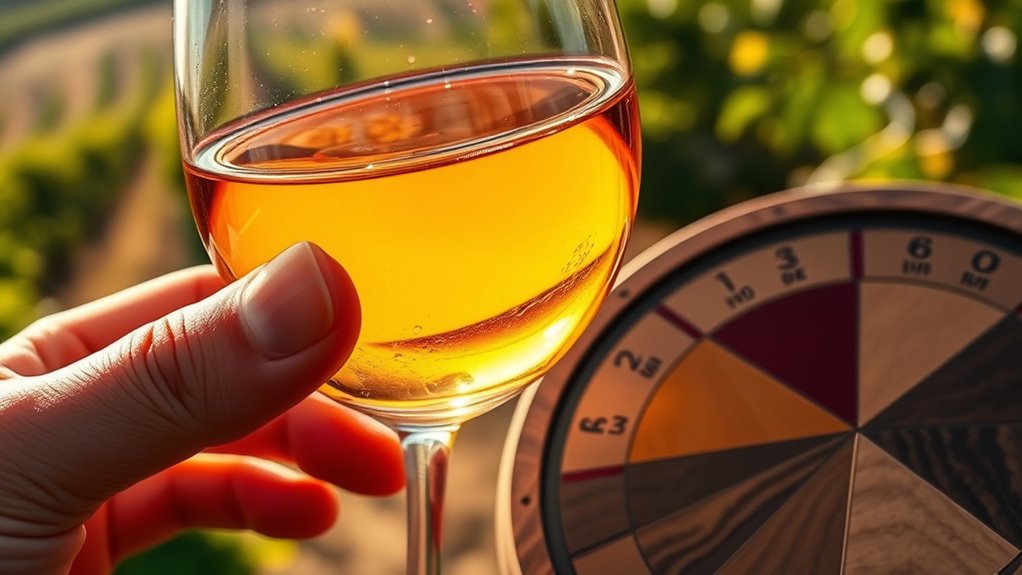Tasting notes are brief descriptions that highlight a wine’s aromas, flavors, structure, and texture, helping you understand its overall character. They serve as a guide to experience the wine’s personality and compare different bottles. Since everyone perceives wine differently, notes reflect personal impressions while providing common language for enthusiasts. Focusing on key scents and tastes makes the experience clearer and more enjoyable. Keep exploring, and you’ll discover even more ways to appreciate each sip.
Key Takeaways
- Tasting notes are brief descriptions of a wine’s aromas, flavors, structure, and texture to guide sensory understanding.
- They help categorize wines, compare profiles, and communicate characteristics among enthusiasts and professionals.
- Descriptors focus on sensory aspects like fruit, floral, herbal, spicy, earthy, and mineral notes.
- Tasting notes are subjective, influenced by personal perception, experience, and mood, but aim for clarity and consistency.
- They enhance appreciation by sharpening the palate, making wine tasting more insightful and enjoyable.

Have you ever wondered how sommeliers and wine enthusiasts describe what they taste? The answer lies in tasting notes—brief yet detailed summaries that capture a wine’s essence. These notes focus on wine aromas, flavors, structure, and texture, serving as a guide through your sensory experience.
Tasting notes are concise summaries capturing a wine’s aromas, flavors, structure, and texture to guide your sensory experience.
When you taste a wine, your perception of its fruit, floral, herbal, spicy, earthy, or mineral notes forms the core of your tasting notes. These descriptors help categorize and compare wines, making your wine tasting more insightful.
Tasting notes are inherently subjective. They reflect personal perception, influenced by your experience, language, and even mood. This subjectivity means that two people might describe the same wine differently, emphasizing different wine aromas and flavors. Despite this, wine descriptors provide a common language for enthusiasts and professionals to communicate a wine’s character effectively.
For example, a wine with prominent citrus and floral notes might be described as fresh and lively, while one with earthy or mineral hints might feel more grounded and complex.
Wine structure and texture are equally important in tasting notes. Structure refers to the wine’s acidity, tannins, and alcohol, which shape how the wine feels on your palate. Texture, on the other hand, describes the mouthfeel—whether it’s smooth, velvety, crisp, or tannic.
Combining these elements helps create a comprehensive picture of the wine’s overall profile, enhancing your understanding of its stylistic qualities.
When writing or interpreting tasting notes, experts recommend keeping descriptions simple and moderate in adjectives. Overloading your notes with too many descriptors can be confusing or overwhelming. Instead, focus on key wine aromas and flavors that stand out, such as ripe berry, jasmine, pepper, or mineral.
This clarity allows for a more accurate reflection of the wine’s true character and makes your wine descriptions accessible to others.
Additionally, understanding how sensory perceptions like aroma and flavor are influenced by factors such as brain function can deepen your appreciation of tasting notes. Whether you’re a seasoned wine taster or just starting out, understanding tasting notes enriches your wine journey. They serve as a shorthand to convey the sensory experience and stylistic nuances of different wine varieties.
Learning to identify and articulate these elements helps deepen your appreciation and sharpens your palate. Ultimately, tasting notes are a vital tool in wine tasting that bridge the gap between personal perception and shared understanding, making every sip a more rewarding experience.
Frequently Asked Questions
What Do Tasting Notes Mean?
When you ask what tasting notes mean, you’re seeking to understand how a wine’s aromas, flavors, and textures are described. They serve as a guide to help you grasp the wine’s overall profile, highlighting key characteristics like fruitiness, acidity, or oak influence.
Tasting notes provide a quick way to compare wines, giving you insight into what to expect and helping you choose wines that match your preferences.
What Are the 5 S’s of Taste?
You’re asking about the 5 S’s of taste. These steps guide you through tasting wine systematically:
First, see the wine’s color and clarity.
Then, swirl it to release aromas.
Next, smell to identify scents.
Sip to experience flavors and textures.
And finally, savor to appreciate the wine’s complexity and finish.
Following these steps helps you enjoy and understand the wine more fully.
How to Read Tasting Notes?
When you read tasting notes, focus on the descriptive words that highlight the wine’s appearance, aroma, taste, and texture. Look for specific aromas like floral or fruity notes, and note how the wine feels—whether it’s balanced, velvety, or crisp.
Pay attention to the overall impression, complexity, and harmony. This helps you understand the wine’s style, origin, and aging potential, making your tasting experience more informed and enjoyable.
How to Identify Tasting Notes?
When you try to identify tasting notes, start by carefully smelling the wine to notice its aromas.
Then, take a small sip and focus on the flavors and textures you experience.
Use tools like aroma kits or flavor wheels to guide you, and practice regularly to sharpen your senses.
With time and attention, you’ll become better at pinpointing specific notes like fruit, floral, or spice.
Conclusion
Understanding tasting notes helps you appreciate each sip more deeply. When you recognize flavors like citrus, oak, or vanilla, you connect better with what you’re drinking. It’s like revealing a secret language that makes every glass more interesting. So next time you enjoy a wine, whiskey, or coffee, pay attention to those notes. They’ll guide you to new favorites and enhance your tasting experience. Cheers to discovering more with every sip!









